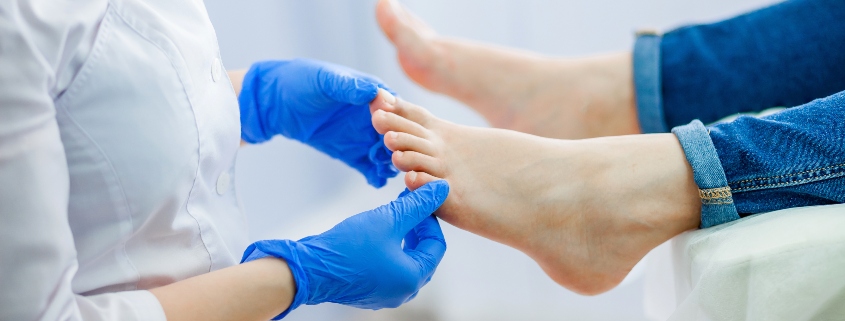Diabetic Foot Ulcer Doctors

How Do You Know if You Have a Diabetic Foot Ulcer?
A foot ulcer is an open sore or wound commonly located on the bottom of the foot. It occurs in approximately 15 percent of patients with diabetes. Of those who develop a foot ulcer, 6 percent will be hospitalized due to infection or other ulcer-related complications. People with type 2 diabetes often have a harder time fighting off infections from ulcers.
The best way to avoid severe ulcer-related problems is to have a podiatrist treat it as soon as possible. Contact the St. Louis podiatrists at Missouri Foot and Ankle for excellent care and treatment.
What Foot Ulcers Look Like
Foot ulcers are red, round craters most commonly located on the bottom of the foot. A foot ulcer can look like a shallow crater on the skin’s surface or it can be very deep. In many cases, a border of thickened, callused skin may develop over time.
A severe deep foot ulcer may extend through the full thickness of the skin and could expose tendons, bones, and other deep structures.
- Symptoms of diabetic foot ulcers may include:
- Swelling, discoloration, and warmth around the wound
- Pain and firmness when the wound is touched
- Foul-smelling discharge seeping from the wound
- A noticeable lump that can be painless
- Fever and chills in advanced stages of foot ulcers
Causes of Diabetic Foot Ulcers
People with diabetes are more likely to develop foot ulcers because of high or fluctuating blood sugar levels and reduced nerve functions. Skin that would normally heal itself may not properly repair due to nerve damage. When the foot cannot heal, an ulcer can develop.
Even the smallest of circumstances, such as stepping on something, a cut or blister, or even wearing tight shoes can develop into a diabetic foot ulcer. Foot ulcers can be difficult to heal, especially since wounds typically heal slower in people with diabetes.
Common factors that cause diabetic foot ulcers are:
- Poor blood circulation – When blood doesn’t flow to your feet efficiently, it is more difficult for ulcers to heal
- High blood sugar (hyperglycemia) – High glucose levels slow down the healing process of an infected foot ulcer, so blood sugar management is critical
- Nerve damage – This causes reduced sensitivity to foot pain and results in unknown wounds that can develop ulcers
- Irritated or wounded feet – Diabetics commonly have dry skin, and their feet may be more prone to cracking, calluses, corns, and bleeding wounds
All people with diabetes are at risk for developing foot ulcers, but these factors can increase that risk:
- Not washing feet regularly or thoroughly
- Improper trimming of toenails
- Heart disease
- Kidney disease
- Diabetes-related eye disease
- Obesity
- Shoes that are ill-fitting or poor quality
- Alcohol consumption
- Tobacco use
Treating Diabetic Foot Ulcers
The knowledgeable diabetic foot ulcer doctors at Missouri Foot and Ankle will examine your foot and determine the most effective method of treatment.
Some treatments may include:
- “Off-loading” (staying off your feet to prevent the ulcer from expanding due to pressure on the ulcer)
- Debridement (removing diseased, dead, or callused skin and tissue)
- Applying medication or a dressing containing silver
- Wearing diabetic shoes or casts
- Surgery
Foot Ulcer Surgical Treatment
In cases when ulcers do not respond to more conservative therapy, surgery may be required. Our surgeons can alleviate pressure around your ulcer by shaving down the bone or removing foot deformities such as bunions or hammertoes. It is extremely important that an infected foot ulcer is properly managed. Surgery can prevent your ulcer from becoming worse or leading to amputation.
Diabetic Foot Ulcer Prevention
The best way to prevent foot ulcers is to make a serious effort to prevent wounds. Avoid walking barefoot, even inside your home. If any foot injury occurs that you believe is minor, have a skilled podiatrist handle it because the issue can easily develop into an ulcer.
These strategies may help prevent foot ulcers:
- Thoroughly examine your feet daily to check for rubbed areas, cracks, or calluses
- Use a mirror to check the heel and sole
- If your vision is not good, ask a relative or caregiver to examine your foot for you
- Practice good foot hygiene
- Wash your feet every day using mild soap and warm water
- Dry thoroughly, especially between your toes
- Moisturize dry areas, but do not put lotion between your toes
- Wear shoes that fit well
- Wear shoe inserts to prevent corns and calluses
- Wear soft, absorbent socks
- Change your socks immediately if they become wet or sweaty
- Trim your toenails straight across
How to Prevent A Foot Ulcer From Becoming Infected
If you develop a sore on your foot, see a doctor right away because the likelihood of infection increases the longer you wait. Even small foot ulcers can become infected and lead to more serious complications that can result in amputation.
Foot ulcer infection can be prevented with:
- Maintaining proper blood glucose levels to facilitate healing
- Foot baths
- Disinfecting the skin around an ulcer
- Frequent dressing changes to keep the ulcer dry
- Enzyme treatments
Contact a Podiatrist for Diabetic Foot Ulcer Treatment
When caught early, foot ulcers are treatable. Have the doctors at Missouri Foot and Ankle examine your foot to develop the right treatment program for your diabetic foot ulcer. Contact us today!
